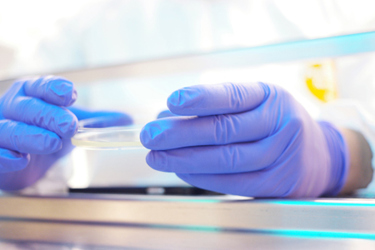Consumables Are Leading The Cleanroom Market — Here's Why
By Pooja Sharma, Global Market Insights

Cleanroom technology plays a pivotal role in ensuring contamination-free environments essential for industries such as pharmaceuticals, biotechnology, and electronics. With advancements in healthcare and the rising need for sterile production conditions, the cleanroom technology market is witnessing robust growth. According to our latest market insights, this industry is expected to reach $9.6 billion by 2032, exhibiting a CAGR of 7.1% over 2024 to 2032, driven by increasing investments in pharmaceutical research and stringent regulatory requirements.
Consumables: Supporting Cleanroom Integrity
While the structural design of a cleanroom forms the backbone of contamination control, consumables play an equally critical role in sustaining the environment’s cleanliness. Items such as gloves, apparel, wipes, disinfectants, and cleaning products are necessary for daily operations and contribute to maintaining the stringent cleanliness levels required. The consumables segment is expected to grow substantially, driven by the frequent need for replacements to meet rigorous standards.
For example, the ISO 14644-1 cleanroom standards, established by the International Organization for Standardization (ISO), provide guidelines for classifying air cleanliness in controlled environments. These standards are essential in sectors where maintaining contaminant-free conditions is non-negotiable, making the use of high-quality consumables critical in adhering to these requirements.
Dominance of gloves and apparel in the consumables segment
Among consumables, gloves and apparel dominate, due to their critical role in maintaining sterile environments. These products are essential in sectors such as pharmaceuticals, biotechnology, and healthcare, where contamination control is paramount. As a result, the demand for high-quality personal protective equipment (PPE) has surged, with market leaders like Kimberly-Clark and Ansell providing innovative solutions designed for maximum contamination control.
However, the procurement of PPE has faced challenges in recent years. Supply chain disruptions, especially during global events such as the COVID-19 pandemic, caused significant shortages and price increases. As production levels have gradually normalized, prices for these items have started to stabilize, though they remain higher than pre-pandemic levels. The increased demand, coupled with disruptions in raw material supply and transportation costs, has resulted in a complex market for PPE.
In response to these challenges, new and established players, including DuPont and Labconco, have introduced eco-friendly alternatives to traditional consumables, further fueling market growth. These products address sustainability concerns and cater to a growing demand for environmentally conscious solutions. This shift aligns with global sustainability goals while meeting the increased need for high-performance consumables in cleanroom environments.
In one example, last year Otect (a subsidiary of PH Group) introduced the N310 cleanroom glove system, which is packaged to reduce cross-contamination, lower glove bioburden, and minimize waste while improving efficiency in dispensing and donning. Additionally, the system uses less packaging, which can contribute to cost savings and lower transportation-related carbon emissions. Such advancements illustrate the industry’s ongoing efforts to enhance cleanroom safety and sustainability.
Pharmaceutical Industry: A Major End-Use Segment
The pharmaceutical industry remains the largest end-user of cleanroom technology, driven by the increasing demand for aseptic manufacturing conditions and compliance with regulatory standards like GMP. With the global pharmaceutical market projected to exceed $2 trillion by 2030, the need for cleanrooms in drug development and production is expected to escalate.
Biotechnology, particularly in the development of advanced therapies like gene and cell treatments, relies heavily on cleanroom environments. Recent expansions in pharmaceutical manufacturing facilities include construction projects by cleanroom and containment specialists aimed at increasing production capacity for bioprocessing applications. In 2024, Wacker Chemie AG and its general contractor Exyte completed Wacker’s mRNA Competence Center in Halle, Germany, a project that includes more than 17,200 square feet of cleanroom space. Meanwhile, last year Franz Ziel began construction of a 21,500-square-foot facility at its Billerbeck, Germany campus to expand its cleanroom containment solutions manufacturing capabilities.
Market Drivers
Technological advancements
Innovations in modular cleanroom systems and integrated HVAC solutions are enhancing efficiency and adaptability. Azbil Corporation, for example, has developed automated cleanroom monitoring systems that use real-time environmental tracking and AI-driven analytics to maintain optimal air quality, temperature, and humidity. These systems help industries improve compliance and reduce operational risks.
Rising healthcare investments
Increased global healthcare spending, particularly in developing regions, is leading to expanded pharmaceutical and biopharmaceutical manufacturing facilities, which require cleanroom environments. For example, in 2024, India announced a $2 billion investment in biopharma infrastructure, significantly increasing demand for cleanroom installations to support vaccine production and sterile drug manufacturing.
Stringent regulations
Compliance with global standards such as ISO 14644 and GMP guidelines has become increasingly critical. While ISO 14644 was introduced over two decades ago, more recent updates — including the revised Part 1 and Part 2 in 2015 — have placed greater emphasis on continuous monitoring of airborne particulate contamination. Additionally, regulatory bodies such as the U.S. FDA and the European Medicines Agency (EMA) have heightened enforcement of cleanroom compliance in response to rising concerns over drug contamination and sterility assurance.
Market Challenges
High initial costs
Establishing a cleanroom facility involves significant up-front costs, including specialized construction, HVAC systems, filtration units, and compliance measures. On average, a basic ISO Class 8 cleanroom can cost $200 to $300 per square foot, while higher-grade cleanrooms (ISO Class 5 to 7) range from $500 to $1,500 per square foot. Annual maintenance, including energy consumption, filter replacements, and monitoring systems, can add another 10% – 15% of the initial investment. These costs present a barrier, particularly for SMEs.
Complex regulatory landscape
Cleanroom requirements vary across regions, making compliance a challenge for global manufacturers. For example, while the U.S. FDA enforces GMP standards for pharmaceutical production, the European Union follows Annex 1 of EU GMP, which was updated in 2022 with stricter contamination control strategies. In Asia, countries like China and India have their own national cleanroom standards, adding another layer of complexity for multinational companies aiming for regulatory alignment across different markets.
Future Outlook
The cleanroom technology market is poised for substantial growth, driven by advancements in modular designs, increasing pharmaceutical R&D, and rising healthcare investments in emerging economies. Other drivers include advancements in contamination control, stringent regulatory requirements, and increasing demand from pharmaceutical and biotechnology sectors. While challenges such as high costs and complex regulatory landscapes persist, ongoing innovations in cleanroom design, air filtration, and automation are shaping the future of the industry. As clean manufacturing standards evolve, cleanroom technology will remain a critical component in ensuring product quality and compliance across multiple sectors.
 About The Author:
About The Author:
Pooja Sharma is a writer at Global Market Insights covering technology, healthcare, and chemical sectors.
